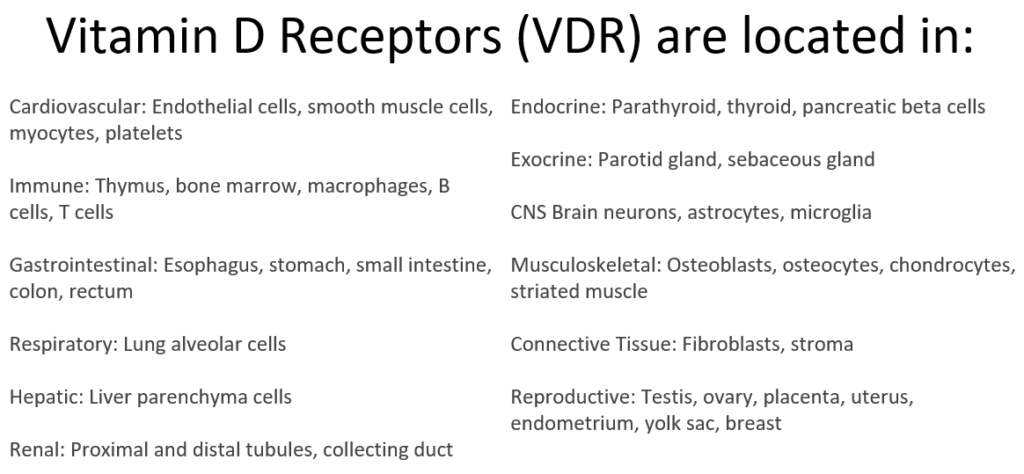Everyone has heard of vitamin D and how it’s important for bone health and the prevention of osteoporosis. But did you know that most cells of the body have receptors for vitamin D?
Cells have receptors for many different hormones and other molecules, like LDL for example. I like to think of them as tiny catcher’s mitts, pulling what is needed into the cell.
I want to focus this post on:
What is Vitamin D
Often called, the sunshine vitamin, D is made in the skin when UVB light hits a cholesterol molecule, thus turning it into vitamin D. Animal foods and some mushrooms contain D as well, but the majority needs to come from the sun. Supplements can raise D levels, but actual benefits can be mixed. Be safe and stick with the sun.
Vitamin D then travels around the body, reaching cells and other tissues to cause a positive response in them. Here is a chart showing all the locations with vitamin D receptors.

Vitamin D and Heart Health
Vitamin D impacts the cardiovascular systems as to how blood vessels function, blood clotting, inflammation, and clotting. The vitamin D receptor has been identified on the surface of smooth muscle cells, endothelial cells, myocardial cells, inflammatory cells controlling their proliferation and differentiation, and even in platelets.
Vitamin D deficiency is linked to other cardiovascular risk factors, such as hypertension, diabetes mellitus, obesity, metabolic syndrome, CIMT (carotid intima-media thickness), and coronary calcification.
Vitamin D deficiency has also been associated with cardiovascular events, such as heart attacks, stroke, congestive heart failure, sudden cardiac death and total mortality. In fact, one trial showed a 500% increased risk of sudden cardiac death with low vitamin D.
Get Tested
Ask your doctor or local lab for a 25-hydroxy vitamin D test. That is the best measure of blood levels. You can also get intracellular testing which is an indicator that D is getting inside the cell.
Goal is to have D levels from 50-70.
Boost Your Levels
I would recommend 2 drops daily of our Super D and 1 cap daily of Super K, along with our multivitamin as a foundation. 4 caps of our MULTI is the standard dose.
Become a Wolf Pack Insider for free and get access to our articles and guides to live healthy naturally, without sickness, disease or Big Pharma meds. You'll learn all about disease prevention, natural treatment remedies, tasty healthy foods and how to detox your life.
Please read the comment policy before replying to this post.